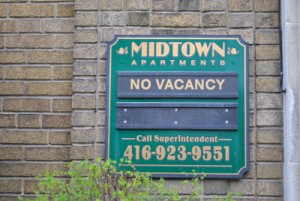‘Hidden Homelessness’ in Toronto
‘Hidden Homelessness’ in Toronto
Recent immigrants and refugees struggle for affordable housing
By Beatrice S. Paez

Intersection: Charles St. and Bloor. ‘The housing stock for affordable rental units dropped significantly in 2009...’
TORONTO–Home is not where the heart is for the city’s recent immigrants and refugees, who are struggling to secure affordable housing, reports a study released by CERIS, a research coalition of Toronto-based universities and community partners.
Measured against the national average income of $69,000, the study finds that a large chunk of the group surveyed spends at least 30% of their average $20,000 income on housing.
Newcomers often have a supportive network of friends and family to ease their integration but lack the resources to pull them from the risk of homelessness.
“Hidden homelessness” continues to define their experiences, the study said, noting that many have bounced from one residence to another. Overcrowding, pest infestation, mould and bad ventilation were cited as the common housing circumstances.
The housing stock for affordable rental units dropped significantly in 2009 when the recession hit and construction projects were cancelled, the report said. Development projects are often intended for the condominium market, while apartment starts have picked up since 2010, it has not reached the levels needed to accommodate the new population.
Consequently, rental costs have been climbing steadily and landlords are in position to choose their tenants more carefully. According to the Toronto Housing Data Bank, average rent has jumped from $914 to $1,017 from 2000 to 2010, with renters’ average incomes lagging behind.
The study also reports that discrimination continues to be an obstacle to affordable housing. Of the 188 participants, 20% reported discrimination. Sponsored refugees are often the targets, bearing the stigma of relying on social assistance and having a large and female-led household, Valerie Preston, a York University Professor and the study’s head researcher said in an interview with The Philippine Reporter.
“They [community agencies] felt that until there was a supply of more low cost rentals, the landlords were going to be able to pick and choose on whatever grounds they like,” said Preston.
The research team recommends that settlement agencies develop their role further by accompanying new arrivals to their appointments with landlords. They also assert that the role can expand to ensure that apartments are safe and adequate.
The study also underscored the need for more accurate information about the housing market. “Sometimes friends and family [do] not have accurate information,” said Preston. “People need more information about their rights as tenants [as well as] their responsibilities.”
The federal government has launched pilot projects aimed at providing housing information to new immigrants, but Preston said it should be made available to all upon arrival. Citizenship and Immigration Canada reports that Canada receives an average of over 254,000 permanent residents each year, and resettles about 10,000 to 12,000 refugees every year.
The Toronto case study is part of a larger project carried out with other Metropolis research teams that examine the housing situation of newcomers in Canada’s “gateway cities” of Toronto, Montréal and Vancouver.
Though rental costs vary from city to city, researchers were surprised to discover that the issue of affordability is comparable across the three cities. “We expected to find big differences between the cities, because we found those in the past,” Preston related in the interview. “In the past newcomers have done better in Montreal, than either in Vancouver or Toronto.”
The research calls for a national strategy developed in concert with all three levels of government to provide incentives and fund affordable housing. In Toronto, there are currently more than 80,000 people on the waiting list for community housing.




Comments (3)